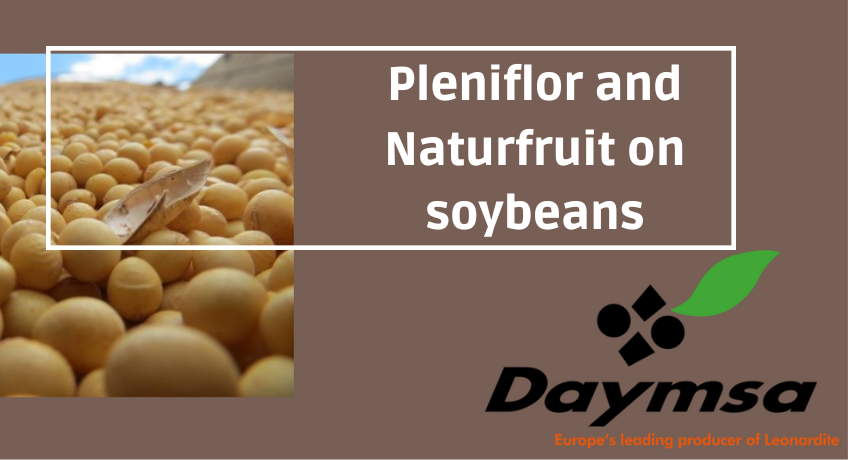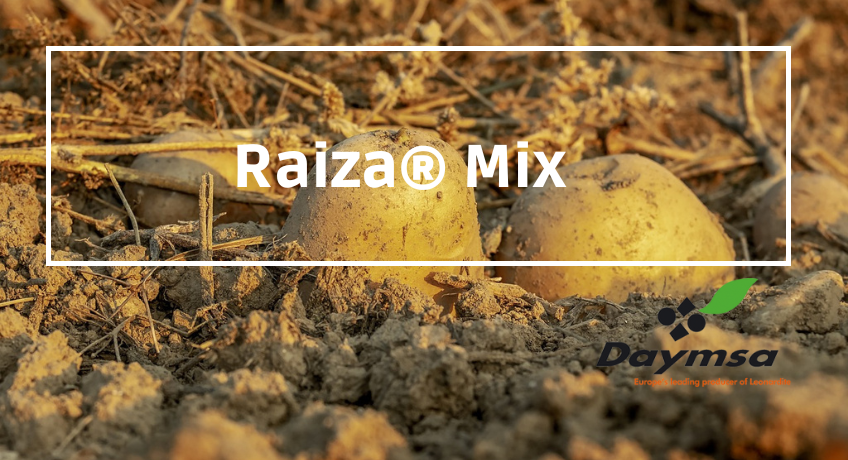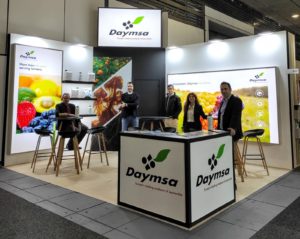
Jun 5, 2023 | Technical articles
Daymsa has carried out trials with Pleniflor and Naturfruit with the main objective of analysing the improvement of grain filling and production in soybean.
Soybean is an annual herbaceous plant, spring-summer, whose vegetative cycle ranges from three to seven months and reaches 40 to 100 cm wingspan. It is a plant sensitive to day length
As regards water requirements, during cultivation, soybean needs at least 300 mm of water, which can be in the form of irrigation when irrigated, or in the form of rain in those humid temperate zones where rainfall is sufficient.
Tests carried out
In order to analyse different vegetative and productive parameters and to increase the production of the soybeans crop, Daymsa has carried out trials on a farm in Salamanca on the Havane variety.
Pleniflor® is a flowering activator.
The phenological stages of the application in soybean (between R1 and R3) were as follows, as can be seen in the following table:
-R1: Beginning of flowering
-R3: Beginning of fruit set
| Var. Nº |
Teatments |
Nº applications |
Dose (l/ha) |
Timing |
| 1 |
UNTRATED PLANTS |
– |
– |
– |
| 2 |
PLENIFOL+NATURFRUIT |
1 |
2+2 |
R1-R3(07 september) |
Results after application of Pleniflor + Naturfruit
The results of the Havane variety after the application of Pleniflor and Naturfruit showed a better flowering and fruit set. After the application of these products, the following data were also analysed, as shown in the table below:
– H%: Percentage of humidity of the grain.
– % Grain protein.
– No. of pods per plant.
– No. of nodes per plant.
– No. of grains per plant.
– Height of the plant (cm).
– Potential yield Kg/ha.
The most important results in terms of percentage compared to the control treatment were as follows:
– Increase in protein content + 7%.
– Increase in the number of grains per pod + 25%.
– Increased yield potential + 25%.
| Variety |
Treatment |
H% |
Protein |
Corrected |
Nº Vainas |
Nº Nudos |
NºGrains |
Height (cm) |
Potential Yield Kg/ha. |
| HAVANE without inocculation |
Pleniflor |
13,39 |
33,5 |
38,68 |
2,5 |
11 |
2,50 |
97 |
4297 |
| HAVANE without innoculation |
Control |
13,58 |
31,3 |
36,22 |
5,50 |
11 |
2,00 |
85 |
3438 |
Pleniflower, flowering and fruit set activator
Pleniflor is a flowering activator and fruit set improver for various crops, especially vegetable and flowering crops.
Pleniflor provides microelements and active substances that are essential in these processes, optimising nutrition at these critical moments. For its preparation, processes are used that maintain all the natural active and soluble components.
Pleniflor is indicated for:
– Stimulating the physiological processes of the plant related to flowering and fruit set, in order to obtain a greater quantity of viable fruit.
– For use mainly on cucurbit species such as melon, watermelon, cucumber, courgette and extensive crops such as rape, soybean and sunflower.

Apr 12, 2023 | Technical articles
Daymsa has carried out a study on seed treatment with Raiza® Mix to analyse the yield and quality of potato production.
Potatoes are one of the most water demanding crops. It needs to have constant availability of this resource to ensure the yield and quality of the tubers, but at the same time it requires well-drained soils to avoid prolonged waterlogging.
During the growing cycle, the potato plants are exposed to the action of a series of pests and diseases, of various origins, which appear during a long period of time, from planting to the end of the vegetative phase. Among the main pests and diseases affecting this crop are the Guatemalan potato moth (Tecia solanivora), the potato flea (Epitrix similars) or the zebra chip (Candidatus Liberibacter solanacearum), the latter usually appearing through invasive insects.
The occurrence of these pests is mainly due to the relatively long period of tuber development in the soil. On the other hand, unfavourable climatic conditions in the period of emergence and subsequent growth of potato plants may be another factor in the occurrence of these pests.
Trials carried out with Raiza® Mix
Daymsa has carried out trials with Raiza® Mix on two potato varieties: Hermes, a Dutch potato, edible, semi-early and useful for the production of French fries, and Tajfun, a medium-early variety that produces large, almost perfectly oval tubers with a slightly yellow skin.
The treatment was carried out a few hours before planting by soaking the potato seeds for 5 minutes in a 0.66% solution, i.e. 0.2 l of Raiza® Mix was dissolved in 30 l of water. The trial was carried out in a light acid soil in a year characterised by an excess of rainfall (134.6 mm above the average of several years) and a significantly different air temperature during the vegetative growing season.
Results
After the application of the 0.66% Raiza® Mix treatment, the Hermes variety achieved an increase in tuber yield of 4.2 t/ha, i.e. 9.9% more than the control, and for the Tajfun variety 4.9 t/ha, i.e. 10.3% more than the control, as shown in the following graphs.
Graph 1. Raiza® Mix effect on the yield of potato variety Hermes
|
Yield potato (t/ha) |
Yield increase (t/ha) |
Increase in performance (%) |
| Control (without treatment) |
42,6 |
– |
100,0 |
| Raiza® Mix (0,66% solution) |
46,8 |
4,2 |
109,9 |
Graph 2. Raiza® Mix on yield of potato Tajfun variety
|
Yield potato (t/ha) |
Yield increase (t/ha) |
Increase in performance (%) |
| Control (without treatment) |
47,7 |
– |
100,0 |
| Raiza® Mix (0,66% solution) |
52,6 |
4,9 |
110,3 |
On the other hand, seed potato treatment with Raiza® Mix also improved the diameter distribution of the tubers produced, which increased the proportion of tubers with a diameter of 35-50 mm for both varieties compared to the control.
Raiza® Mix also contributed to increase in the starch and dry matter content of the tubers compared to the control. The level of nitrate in the tubers was relatively low as shown in the tables below. Regarding the vitamin C content in the fruits, an increase of 20% was achieved in the Tajfun variety, compared to the control treatment.
Graph 3. Effect of Raiza® Mix on the composition of tubers of the Hermes variety
|
Starch (%) |
Nitrate (mg/kg) |
Vitamin C (mg/kg) |
Dry matter (%) |
| Control (without treatment) |
16,0 |
27 |
131,1 |
22,1 |
| Raiza® Mix (0,66% solution) |
16,5 |
34 |
127,7 |
22,6 |
Graph 4. Effect of Raiza® Mix on the composition of Tajfun variety tubers.
|
Starch (%) |
Nitrate (mg/kg) |
Vitamin C (mg/kg) |
Dry matter (%) |
| Control (without treatment) |
15,9 |
28 |
112,5 |
22,1 |
| Raiza® Mix (0,66% solution) |
16,4 |
35 |
134,5 |
22,5 |
Conclusions
The tests carried out showed that after the application of Raiza® Mix on potato seed, great benefits such as increased yield or improved tuber quality were reflected.
In this sense, the application of this product on potato seed stimulated root development and improved nutrient absorption after sowing, favouring uniform germination, vigorous and stress-resistant plants, and helping the crop to reach its maximum productive potential.

Feb 1, 2023 | Daymsa´s news
With just one week to go before the biggest international event in the fruit and vegetable sector, Fruit Logistica, Daymsa confirms its attendance in Berlin from the 8th to the 10th of February.
Daymsa confirms its presence as an exhibitor at this international event in order to present to the sector the key of its activity, as well as the research of new products and their development in order to achieve a high level of quality.

Daymsa at Fruit Logistica
In this sense, the company did not want to miss out on having a presence at this benchmark event such as Fruit Logistica, the leading trade fair specialising in the world fruit and vegetable trade, which returns to its usual date from the 8th to the 10th of February and which aims to recover attendance figures prior to the pandemic.
Berlin will be transformed into the capital of the world’s fresh fruit industry. More than 2,492 exhibitors from 87 countries have confirmed their attendance and more than 72,000 trade visitors are expected.
Come and visit us! stand B-07 in Hall 10.2
DAYMSA; biostimulants and biocontrol products for sustainable agriculture
Daymsa, the first European producer of Leonardite, started its activity in 1979, manufacturing humic acid based biostimulants. Daymsa is a reference in high quality technological solutions in biostimulants and biocontrol products. Agriculture is facing challenges such as exponential population growth with limited resources, restriction of effective active ingredients against pests and diseases, climate change, etc, and needs cost-effective and sustainable solutions.
Daymsa is committed to continue developing solutions to meet the demands of today’s agriculture, obtaining maximum yield and protection without crop residues.




